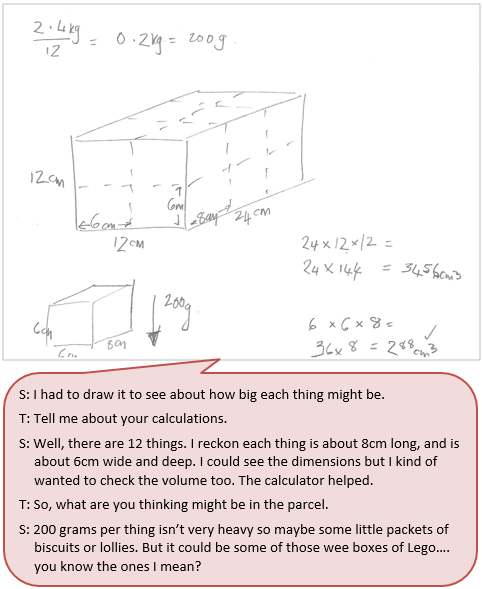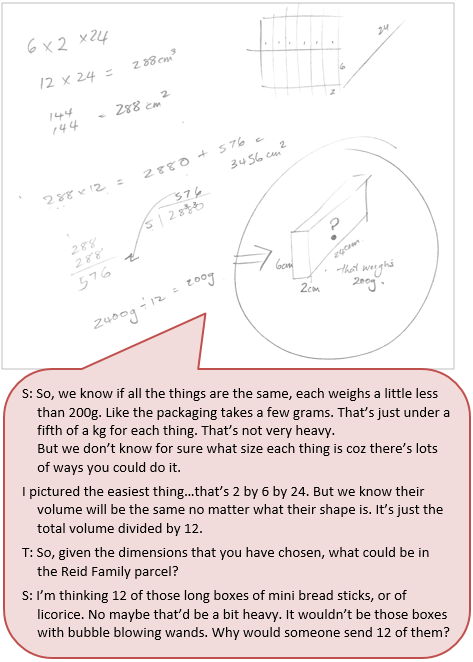Noah’s Mystery Parcel
The purpose of this activity is to engage students in solving a measurement problem involving volume and weight.
This activity assumes the students have experience in the following areas:
- Recalling multiplication and division facts.
- Working with metric units for length and mass.
- Calculating the volume of a rectangular prism.
- Measuring the mass of objects using scales.
The problem is sufficiently open ended to allow the students freedom of choice in their approach. It may be scaffolded with guidance that leads to a solution, and/or the students might be given the opportunity to solve the problem independently.
The example responses at the end of the resource give an indication of the kind of response to expect from students who approach the problem in particular ways.

This mystery parcel has arrived for Noah’s family.
The packaging label is damaged.
Noah wonders what could be inside.
When he measures the parcel he finds it is 24cm long and the
square ends measure 12cm x 12cm.
Say what you think could be in the parcel and why you think that.
The following prompts illustrate how this activity can be structured around the phases of the Mathematics Investigation Cycle.
Make sense
Introduce the problem. Allow students time to read it and discuss in pairs or small groups.
- Do I understand the situation?
- What information do we know about the total contents of the box?
- Is any information missing? How will I find out that information?
- What will my solution look like? (The solution will be suggestions for the contents of the box based on correct calculations of volume and mass.)
Plan approach
Discuss ideas about how to solve the problem. Emphasise that, in the planning phase, you want students to say how they would solve the problem, not to actually solve it.
- What strategies might I use? (Diagrams and physical models might prove useful.)
- What are the maths skills I need to work this out? (Students should identify their measurement knowledge and skills for mass and volume.)
- What could the solution be? What objects match the information?
- How will I record my workings so they are clear to myself and others?
- What tools (digital or physical) could help my investigation?
Take action
Allow students time to work through their strategy and find a solution to the problem.
- Am I recording my workings in a clear, step-by-step way?
- Is my strategy working or should I try something else?
- Does my answer seem correct? Does it match my prediction?
- Am I gathering evidence to justify my answer? What kind of evidence have I got?
- Does my solution make sense? Does it match my estimation?
- Does my solution answer the question?
- Is there another possible way to solve it?
Convince yourself and others
Allow students time to check their answers and then either have them pair share with other groups or ask for volunteers to share their solution with the class.
- What is my solution?
- Is my working clear for someone else to follow?
- Am I sure that my calculations for volume and mass are correct?
- Can I justify that I am correct? How?
- Could I have solved the problem in a more efficient way?
- What maths did I use? Is there some more maths that I need to learn?
Examples of work
Work sample 1
The student sketches a diagram of the box and uses three dimensions to calculate a possible size for each object. They divide the mass by 12 to get the mass of each object. From that estimate they suggest possibilities for the contents that are realistic.
Click on the image to enlarge it. Click again to close.
Work sample 2
The student sketches a diagram of the box and uses three dimensions to calculate a possible size for each object. From the calculations of volume and mass they suggest possibilities for the contents that are realistic.

